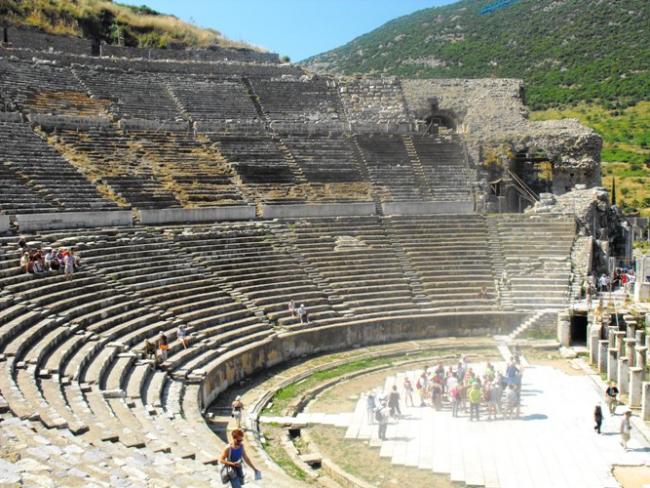Ephesus was originally built by the Greeks and then expanded and inhabited by the Romans, Byzantines and the Turks. Now a popular archeological site for travellers in Turkey, Ephesus has distinct examples of Greek, Roman and Byzantine architecture and reveals the daily life of ancient people.
Located near the Turkish town of Selcuk, Ephesus used to be located on the Mediterranean coast, and was one of the 12 main cities of the Greek Empire and one of the largest cities of the Roman Empire. I was very curious to see this ancient site – and from my guide found out that more than 50 per cent of the vast city is still buried beneath layers of earth.
The first major monument on the site you’ll see is the small amphitheatre, used by the government for debate and discussion. You can climb to the top of this amphitheatre, which gives a unique perspective of this upper part of the site, as this is where the upper crust of ancient society lived and socialized.
The guide pointed out numerous architectural details created by the ancient empires and the various gods and goddesses still visible in the carved stone centuries later. Nike, whose name and symbol is used by the American sportswear brand, can be seen with her distinctive symbol in a large sculpture.
Ephesus benefitted from many of the conveniences created by the Romans including a sophisticated aqueduct system to bring in fresh water and remove waste water from the city. Heading downhill along a stone pathway, the guide lets me know that we’ve now passed into the main city, where the ordinary citizens lived and worked. Daily life included public baths, toilets and a large brothel, as well as the structures of stores and businesses; all these remnants are from the first century BC, when the city had a population of 250,000 during the Greek empire.
The main focus of the site is the Roman Temple of Artemis, whose façade is still standing, and was named one of the seven wonders of the ancient world. This temple housed one of the ancient world’s largest libraries, the Library of Celsus, which at one time held 12,000 scrolls. In its heyday under Roman rule, Ephesus was home to almost 500,000, and the capital of the Asia as decreed by Augustus Caesar.
Farther along from the Temple is the main amphitheatre, where locals would gather for music, theatre and other kinds of entertainment. Finished in the second century by the Romans, the amphitheatre could hold 25,000 spectators. The stone steps are worn but still passable for anyone who wants to make the climb to the top.
As I descended from the amphitheatre and headed towards the site’s exit, the guide explained that this road was the main entry way for the ancient city. As I walked the same path that had felt the footsteps of citizens for centuries, I hoped that in the next century, people would still be able to come to Ephesus, to learn about the empire builders of the past.


